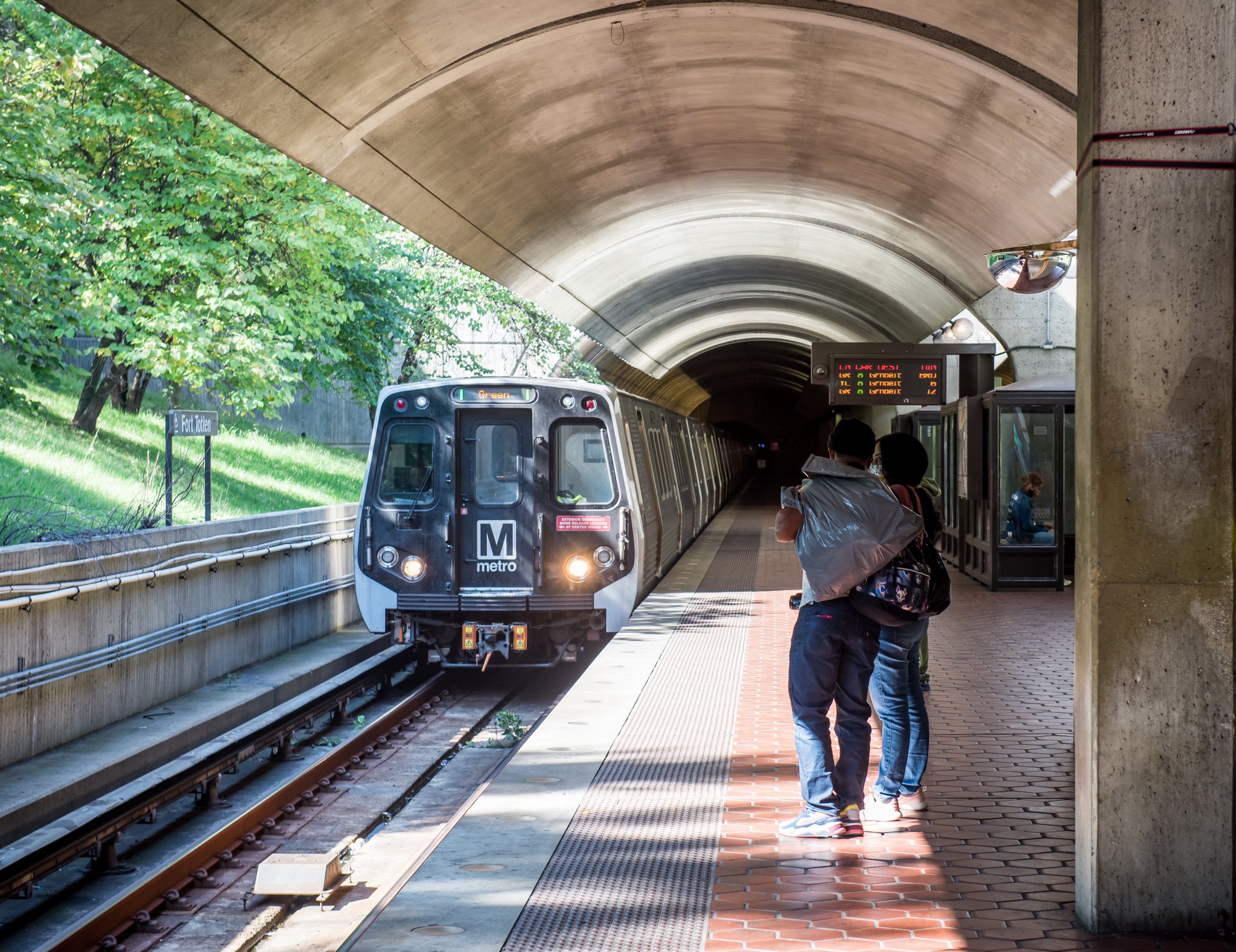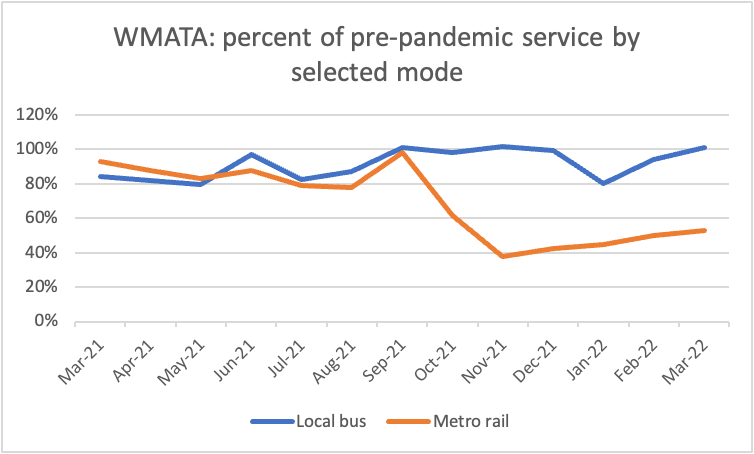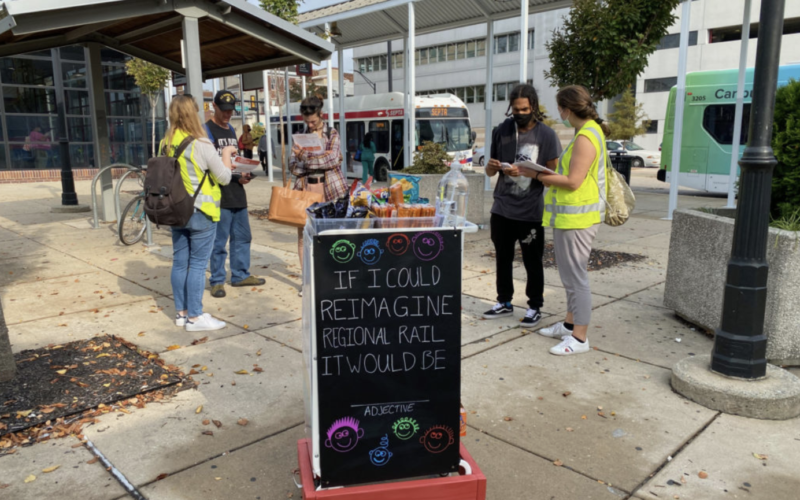
This week we’re running a series that looks into what’s happening with transit service in the seven highest ridership U.S. cities. Our goal with this series is to facilitate a shared understanding of the challenges agencies are facing, give riders a sense of what they can expect for the remainder of 2022, and surface ideas for how agencies can better mitigate disruptions.
What’s going on with transit service in DC?

Similar to MBTA, WMATA had implemented an ambitious return to pre-pandemic service levels throughout much of 2021. But mechanical concerns on the 7000-series train cars following an October derailment caused rail service to collapse. And in May 2022, news that nearly half of Metro’s 500 rail operators had lapsed recertifications have further impacted service. In June, WMATA was able to return some of the 7000-series cars into service, leading to a partial restoration. The agency has budgeted for 100% of pre-pandemic service once mechanical and recertification issues have been ironed out.
WMATA’s Catherine Vanderwaart (Director of Analytics, Office of Planning) called attention to the agency’s strong bus service levels:
“Metrobus is running approximately 100% pre-pandemic revenue vehicle hours across the week, but we have intentionally shifted some resources to improved off-peak and weekend frequency with the launch of the Frequent Service Network in September 2021. This helps us better serve the essential workers and equity communities that have been our core customer base throughout the pandemic. Some routes now exceed pre-pandemic service levels, while some routes (especially commuter-oriented routes) are either not operating, or are operating at reduced levels or combined with other routes.” (See: Frequent Service Network changes.)
WMATA is holding off on more significant changes to the bus network until its full bus network redesign launches. But the Frequent Service Network remains a step toward bringing transit service in line with pandemic-era commuting needs and priorities by implementing 12- and 20-minute (or better) service on 36 separate lines, with 29 operating at the 12-minute or better standard. Included among the Network’s goals are: a) improving late evening frequency, b) improving weekend frequency, and c) standardizing weekday off-peak frequency. WMATA’s FY2023 budget proposes to make the Frequent Service Network changes permanent.
Beyond the 7000-series railcar availability issues and operator availability, Vanderwaart lists on-street traffic congestion and rail system construction as present, ongoing challenges for the agency.
The agency’s goals for the rest of 2022, according to Vanderwaart, include:
Metrorail
– “Return of the 7000-series railcars
– Open the Silver Line extension to Dulles International Airport and Ashburn
– Open Potomac Yard station (an infill station)”
Metrobus
-“Continue to work with DDOT and other jurisdictions on bus priority projects, such as the 16th Street NW bus lane project that is currently under construction
-Begin work on the Bus Network Redesign”
Ron Thompson, policy officer at Greater Greater Washington and coordinator of the DC Transportation Equity Network, says with WMATA’s recent hire of Randy Clarke as new General Manager, “it’s the right moment in time for the transit agency to chart a strong course that adapts to the Washington region’s “new normal” as the pandemic evolves and the agency returns the 7000-series cars to service. For Metrorail, that may look like increased all-day service, given changes to commuting and travel patterns. For Metrobus, it may mean 10-15 minute headways on most major routes and a reduction in cuts to service, to ensure that essential workers and underserved communities have access to reliable transportation. With a nationwide bus operator shortfall and a looming, unprecedented fiscal cliff at WMATA, this isn’t going to be easy. It will require political will to resolve and tough conversations about long-term, sustainable solutions.”
Read other posts in this series about LA Metro, Boston’s MBTA, and Chicago’s CTA.
 On the Brink: Will WMATA’s Progress Be Erased by 2024?
On the Brink: Will WMATA’s Progress Be Erased by 2024?
The experience of being a WMATA rider has substantially improved over the last 18 months, thanks to changes the agency has made like adding off-peak service and simplifying fares. Things are about to get even better with the launch of all-door boarding later this fall, overnight bus service on some lines starting in December, and an ambitious plan to redesign the Metrobus network. But all of this could go away by July 1, 2024.
Read More A Transit Revolution in Philadelphia?
A Transit Revolution in Philadelphia?
The Southeastern Pennsylvania Transportation Authority (SEPTA) has been working throughout the pandemic on several system-wide planning initiatives that have the potential to transform transit service in and around the city of Philadelphia.
Read More